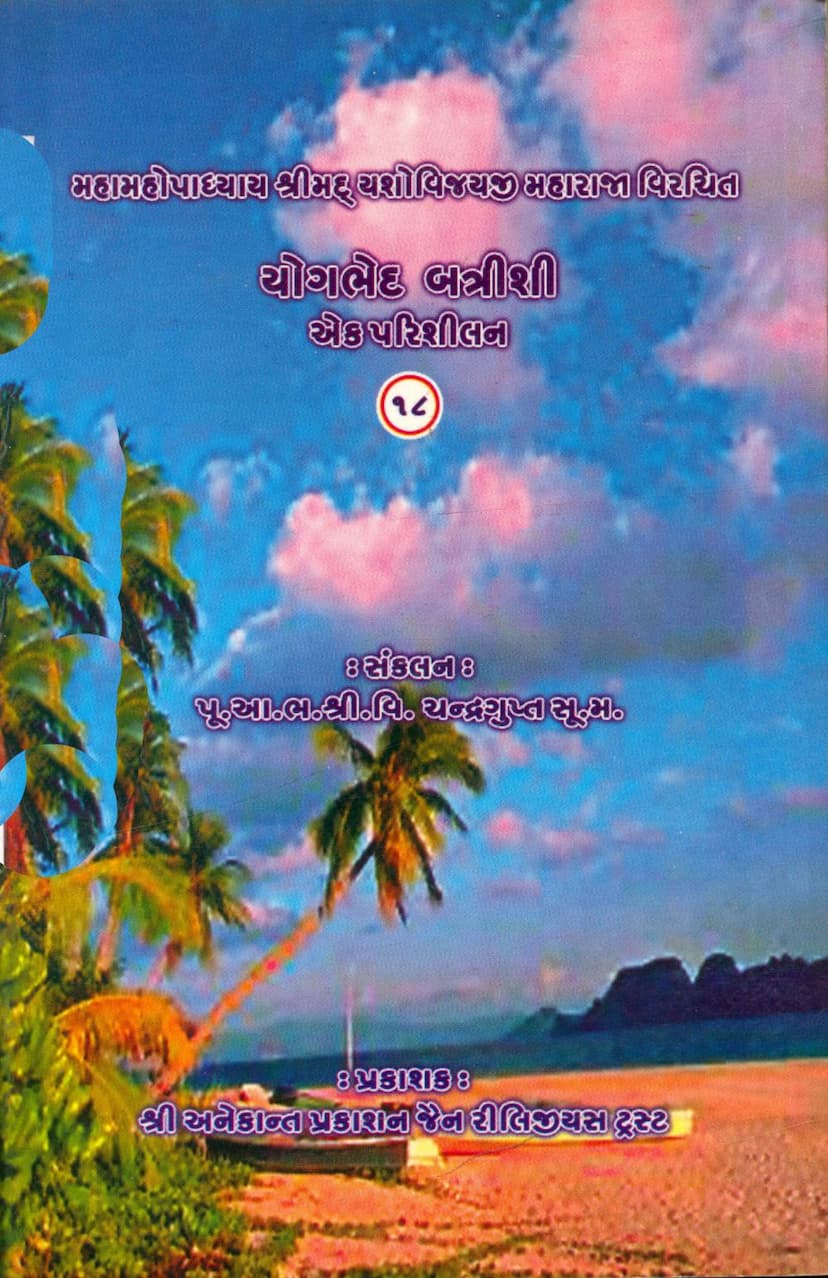Yog Bhed Battrishi Ek Parishilan
Added to library: September 2, 2025

Summary
This document is an analysis of "Yog Bhed Battreeshi," a section within the larger work "Tritritri" by Mahamahopadhyay Shrimad Yashovijayji Maharaj. The analysis is authored by Acharya Shri Chandraguptasuri.
The core of the text discusses the five types of yoga as described in Jain philosophy, which are essential for spiritual liberation (moksha). These five types are:
-
Adhyatma (Self-Realization/Spirituality): This is the primary path to moksha, involving the union of the soul with liberation. It is achieved through contemplation of truth, guided by scriptures (Agama). A crucial element of Adhyatma is the cultivation of mental states of friendliness (Maitri), compassion (Karuna), sympathetic joy (Mudita), and equanimity (Upeksa) towards all beings. The text details the cultivation of these bhavanas (mental states), explaining their nuances and how they help overcome obstacles to spiritual progress, such as envy of the happy, indifference to the suffering, and aversion to virtue.
-
Bhavna (Cultivation/Meditation): Bhavna is described as the sustained practice of Adhyatma. It is categorized into five types, corresponding to knowledge (Jnana), perception (Darshan), conduct (Charitra), austerity (Tapa), and dispassion (Vairagya). The consistent practice of Bhavna leads to strong spiritual impressions (samskaras), which are vital for continuous spiritual progress and ultimately achieving the final goal.
-
Dhyana (Concentration/Meditation): This involves focusing the mind on a single, auspicious object without distraction from other thoughts. Achieving Dhyana requires diligently abandoning eight mental disturbances: sorrow (Kheda), agitation (Udvega), confusion (Bhrama), restlessness (Utthan), distraction (Kshera), attachment (Asanga), unsteadiness (Anyamudra), and illness (Roga). Cultivating a mind free from these eight defects leads to beneficial Dhyana, bringing self-mastery and eradicating negative karmic tendencies.
-
Samata (Equanimity): Samata is the state of equanimity achieved through understanding the true nature of reality (Tattvabuddhi). It arises from overcoming the misconceptions and deluded perceptions about worldly objects and experiences that have been ingrained since beginningless time due to ignorance (avidya). When the mind is undisturbed like a waveless ocean, devoid of all conceptualizations, it leads to Samata. This state is characterized by seeing things as they truly are, without attachment or aversion.
-
Vritti-Sankshaya (Cessation of Mental Modifications): This is the highest state of yoga, described as the complete cessation of all mental activities and modifications. This state is attained at the time of acquiring omniscience (Kevalajnana) and during the Shaileshi state, leading to ultimate liberation (moksha).
The text also elaborates on the eight obstacles (doshas) to achieving Dhyana, explaining each one in detail with examples. These are:
- Kheda (Sorrow/Discouragement): Arising from effort without immediate perceived results, hindering mental stability.
- Udvega (Agitation/Restlessness): Arising from dislike of the yogic path, making practice feel like forced labor and obstructing birth in a spiritual lineage.
- Bhrama (Delusion/Confusion): Perverting the mind, preventing the formation of correct impressions about actions performed or not performed, thus undermining yogic practice.
- Utthan (Wavering/Lack of Steadiness): The absence of a continuously calm mental state, leading to wavering and an inability to achieve the fruit of practice.
- Kshera (Scattering/Distraction): The mind being drawn to other things during practice, rendering the effort unfruitful, like repeatedly uprooting paddy plants.
- Asanga (Attachment/Fixation): An excessive attachment to a particular practice, leading to a lack of progression to higher stages and a stagnation in one's current spiritual level.
- Anyamudra (Wrong Focus/Diversion): Developing affection for practices that are not in line with the prescribed path, leading to an indifferent or even destructive approach to the actual practice.
- Roga (Disease/Affliction): An impurity or breakage in the correct practice, making the entire effort fruitless, like a crop afflicted by disease.
The text concludes by stating that these five types of yoga, when practiced diligently in accordance with the teachings of the Jinas (Tirthankaras), lead to the supreme state of bliss and liberation. It emphasizes that these yogic practices, particularly Adhyatma, Bhavna, Dhyana, Samata, and Vritti-Sankshaya, are the means to achieve the ultimate goal of spiritual perfection and eternal happiness. The analysis highlights that these yogic paths, when followed, purify the mind, destroy karmic bonds, and ultimately lead to the cessation of suffering and the attainment of moksha.